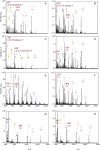Disruption of Golgi morphology and altered protein glycosylation in PLA2G6-associated neurodegeneration
- PMID: 26668131
- PMCID: PMC5535303
- DOI: 10.1136/jmedgenet-2015-103338
Disruption of Golgi morphology and altered protein glycosylation in PLA2G6-associated neurodegeneration
Abstract
Background: Mutations in PLA2G6, which encodes the calcium-independent phospholipase A2 group VI, cause neurodegeneration and diffuse cortical Lewy body formation by a yet undefined mechanism. We assessed whether altered protein glycosylation due to abnormal Golgi morphology might be a factor in the pathology of this disease.
Methods: Three patients presented with PLA2G6-associated neurodegeneration (PLAN); two had infantile neuroaxonal dystrophy (INAD) and one had adult-onset dystonia-parkinsonism. We analysed protein N-linked and O-linked glycosylation in cerebrospinal fluid, plasma, urine, and cultured skin fibroblasts using high performance liquid chromatography (HPLC) and matrix-assisted laser desorption ionization--time of flight/mass spectrometry (MALDI-TOF/MS). We also assessed sialylation and Golgi morphology in cultured fibroblasts by immunofluorescence and performed rescue experiments using a lentiviral vector.
Results: The patients with INAD had PLA2G6 mutations NM_003560.2: c.[950G>T];[426-1077dup] and c.[1799G>A];[2221C>T] and the patient with dystonia-parkinsonism had PLA2G6 mutations NM_003560.2: c.[609G>A];[2222G>A]. All three patients had altered Golgi morphology and abnormalities of protein O-linked glycosylation and sialylation in cultured fibroblasts that were rescued by lentiviral overexpression of wild type PLA2G6.
Conclusions: Our findings add altered Golgi morphology, O-linked glycosylation and sialylation defects to the phenotypical spectrum of PLAN; these pathways are essential for correct processing and distribution of proteins. Lewy body and Tau pathology, two neuropathological features of PLAN, could emerge from these defects. Therefore, Golgi morphology, O-linked glycosylation and sialylation may play a role in the pathogenesis of PLAN and perhaps other neurodegenerative disorders.
Keywords: Cell biology; Molecular genetics; Neuromuscular disease.
Published by the BMJ Publishing Group Limited. For permission to use (where not already granted under a licence) please go to http://www.bmj.com/company/products-services/rights-and-licensing/
Conflict of interest statement
Figures




References
-
- Carrilho I, Santos M, Guimaraes A, Teixeira J, Chorao R, Martins M, Dias C, Gregory A, Westaway S, Nguyen T, Hayflick S, Barbot C. Infantile neuroaxonal dystrophy: what’s most important for the diagnosis? Eur J Paediatr Neurol. 2008;12:491–500. - PubMed
-
- Gregory A, Westaway SK, Holm IE, Kotzbauer PT, Hogarth P, Sonek S, Coryell JC, Nguyen TM, Nardocci N, Zorzi G, Rodriguez D, Desguerre I, Bertini E, Simonati A, Levinson B, Dias C, Barbot C, Carrilho I, Santos M, Malik I, Gitschier J, Hayflick SJ, Guimaraes A, Teixeira J, Chorao R, Martins M, Westaway S, Nguyen T, Hayflick S. Neurodegeneration associated with genetic defects in phospholipase A(2) Neurology. 2008;71:1402–9. - PMC - PubMed
-
- Kurian MA, Morgan NV, MacPherson L, Foster K, Peake D, Gupta R, Philip SG, Hendriksz C, Morton JE, Kingston HM, Rosser EM, Wassmer E, Gissen P, Maher ER, McNeill A, Lin JP, Hayflick SJ. Phenotypic spectrum of neurodegeneration associated with mutations in the PLA2G6 gene (PLAN) Neurology. 2008;70:1623–9. - PubMed
Publication types
MeSH terms
Substances
Supplementary concepts
Grants and funding
LinkOut - more resources
Full Text Sources
Other Literature Sources
Medical
Research Materials
